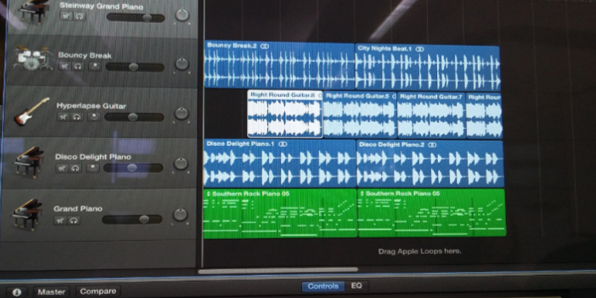In the music session, we used Garageband to experiment with editing sound effects into an animation to provide a backing track as “computers allow children to manipulate musical sounds” (Bloomsfield and Childs, 2000, p.78).
This was a fun and creative activity as Garageband allows the user to change key, tempo, beat and interchange instruments. I look forward to using this program in my own teaching practice as I found it accessible, useful and easier to edit than programs such as iMovie. These benefits are supported by Bloomsfield and Childs, (2000, p.78), as “ICT provides children with many opportunities to access music-making, [as it] gives rapid access to information and provides the individual with final results which look and sound good.”
We were also introduced to a number of useful websites that can strongly assist in children’s learning such as Charanga, Incredibox, Weebles and Findsounds. This was incredibly useful as it helps to build up a repertoire of a variety of resources to use, all of which can be transferred easily between being a learner and a teacher.
In the drama session, a few groups performed micro-teaching tasks whereby they demonstrated a few dramatic techniques based on a chosen text. My group chose Harry Potter where we had freeze frames, teacher in role and improvisation. I felt the class engaged with this well, as students who were not familiar with this text seemed to enjoy it.
Furthermore, the creative solutions surprised me which made this experience more beneficial and provided me with an opportunity to present to my peers and experience what planning and teaching a short drama activity would be like. This was also a useful insight into the possible curricular links between literacy and drama as integrated arts “connection making is the core mechanism of curriculum integration” (Marshall, 2014, p.3).
We then moved on to concentrate on World War 2 and how this can be a great source for drama as it provides many topics within that are appropriate for children to dramatize. Some of these included: Anne Frank, The Blitz, evacuees and concentration camps. We were asked to come up with appropriate drama techniques for a chosen topic. My group chose to do a freeze frame for the emotions of evacuees upon leaving their family behind to live in the countryside. This is a great activity for children to empathise with evacuees, as well as integrating history within drama.
From this session, I have learned to overcome many fears that surfaced within the first drama input as well as how easily drama can be used to enhance many academic subjects.
Overall, successful drama educators should aim to develop “imaginative play and exploration, curiosity and agency, collaborative engagement and reflection, and innovation and risk-taking” (Jones and Wyse, 2013, p.85).
References
Bloomfield, A and Childs, J (2000) Teaching Integrated Arts in the Primary School: Dance, Drama, Music and the Visual Arts [Print] Great Britain: David Fulton
Jones, R and Wyse, D (eds) (2013) Creativity in the Primary Curriculum (2nd ed) [Print] Oxon: Routledge
Marshall, J (2014) Transforming Education Through Art Centered Integrated Learning [Online] Available: https://static1.squarespace.com/static/54cfc63de4b08a9c05c7b299/t/55ad8587e4b099ab1ca12d0e/1437435271198/Integrated_Learning_and_Transforming_Education.pdf [Accessed: 12 December 2016].

